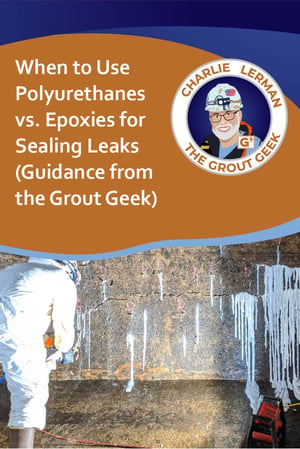
 Charlie Lerman, a.k.a. "The Grout Geek", is Alchemy-Spetec's Director of Technical Services - Leak Seal Division. The importance of waterproofing became critical to him while serving on nuclear submarines in the U.S. Navy. With decades of experience in construction and leak seal, Charlie commands unparalleled expertise in grouting techniques and water mitigation.
Charlie Lerman, a.k.a. "The Grout Geek", is Alchemy-Spetec's Director of Technical Services - Leak Seal Division. The importance of waterproofing became critical to him while serving on nuclear submarines in the U.S. Navy. With decades of experience in construction and leak seal, Charlie commands unparalleled expertise in grouting techniques and water mitigation.
Cracks in Concrete Left Unchecked
Although it’s not unusual to find cracks in concrete, they could lead to detrimental structural issues in the future if not taken care of immediately. But why do concrete structures seem to crack so easily? This issue often occurs due to movement caused by thermal conditions and expansive soils.
And over time, you’ll typically see that these concrete cracks can widen and result in water infiltration, and corrosion of the reinforcing steel. The worst-case scenario we want to avoid is the structural integrity becoming compromised. These cracks are not only a bad look, but they can seriously threaten the lifespan of the structure if left unchecked.
A Quick Look at Polyurethanes vs. Epoxies
This naturally leads us to the next important question to answer: how can we fix it? As usual, there are a few methods used to tackle this problem. In this post, we will cover two popular but different methods: polyurethanes vs epoxies. The reality is that both products can work to address cracks in concrete but under very different conditions.
Due to high compressive strengths, Epoxy is used for cracks in need of structural repair. Often, epoxies even have higher strength ratings than the concrete being repaired. This is why they are the best choice for structural cracks.
Nonstructural cracks that are not leaking are rarely addressed for anything other than cosmetic repairs. This brings us to leaking nonstructural cracks. These cracks are often dynamic in nature. Repairing these moving cracks with epoxy can prove difficult and often results in mirror cracking (a process in which the structural movement causes the original crack pattern to reappear in the applied epoxy). Thus it is imperative to repair leaking nonstructural cracks with flexible polyurethane foam. Flexible polyurethane can move with the structure and still maintain a water-tight seal.
Leaking Cracks in a Parking Garage
A few years back I was asked by an engineer to look at a parking garage that had many leaking cracks. It turned out that it was previously "repaired" with epoxy, yet all the cracks and leaks had reappeared. This is a perfect example of why grouters should not use epoxy in leaking cracks. Another common mistake is to use a rigid (rather than flexible) polyurethane in a dynamic crack.
So the simple takeaway is to remember that epoxies are for structural repairs and polyurethanes are for waterproofing.


